Potting Mixtures
Unlock the Secret to the Perfect Potting Mix: Grow Thriving Potted Plants!
Potting mix is a type of soil-less mixture that is specifically designed for potted plants. Unlike garden soil, potting mix is lighter and more porous, which helps to provide optimal growing conditions for plants in containers.
Filter By
-
Sale!
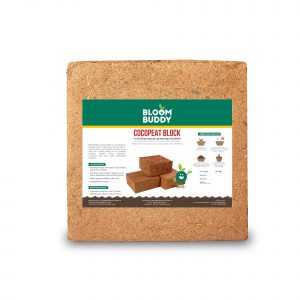
Cocopeat Block 4.5kg
Original price was: ₹590.₹399Current price is: ₹399. -
Sale!
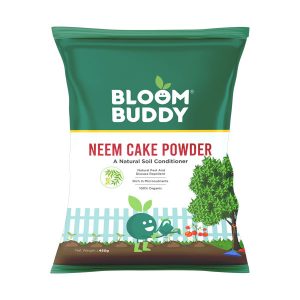
Neem Cake Powder 450G
Original price was: ₹230.₹209Current price is: ₹209. -
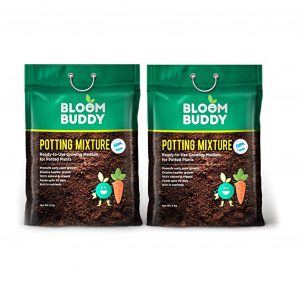
Soilless Potting Mixture 10kg
₹999 -
Sale!
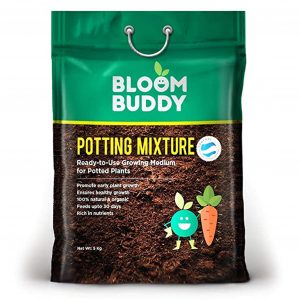
Soilless Potting Mixture 5kg
Original price was: ₹599.₹588Current price is: ₹588. -
Sale!
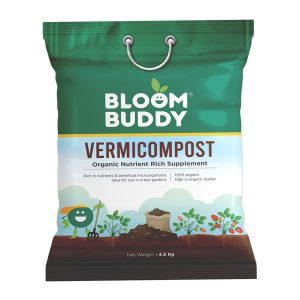
Vermicompost 4.5kg
Original price was: ₹799.₹420Current price is: ₹420. -
Sale!
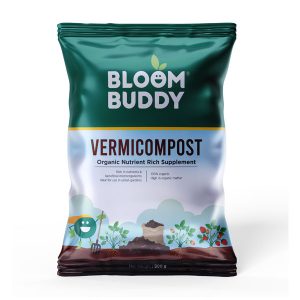
Vermicompost 900g
Original price was: ₹320.₹190Current price is: ₹190.
Importance of Potting Mix for potted plants
Potted plants require different growing conditions than plants grown in the ground. They need a potting mix that provides proper drainage, aeration, and water retention. Using the right potting mix is essential for keeping potted plants healthy and thriving. A good potting mix can help to reduce the risk of disease, improve root development, and increase overall plant growth and vitality. There are two main types of potting mixes for plants: soil-based and soilless. Soil-based potting mix is a mixture of garden soil, compost, and other organic matter. This type of mix provides plants with a familiar growing environment, and it often contains essential nutrients for plant growth. However, soil-based mixes can become heavy and compact over time, making it difficult for roots to penetrate.
Soilless potting mix, on the other hand, is made from a combination of peat moss, perlite, vermiculite, and other inorganic materials. This type of mix is light, airy, and drains well, making it ideal for potted plants that require good drainage. Soilless mixes are also often sterile, which helps to prevent the growth of harmful bacteria and fungi.
Both soil-based and soilless potting mixes have their own unique benefits and drawbacks, and the choice of mix will depend on the specific needs of the plants being grown.
Potting Mix Composition
Soil: Soil forms the basic structure of potting mix and provides essential minerals and nutrients to plants. However, soil from the garden is often too heavy and compact for potted plants, which is why a specially designed potting mix is necessary.
Vermiculite or Perlite: Vermiculite and perlite are both types of minerals that are commonly used in potting mix. They help to improve soil aeration and drainage, which is critical for preventing root rot and other plant diseases. Perlite has a higher water-holding capacity than Vermiculite, while perlite has better air space, making it a better option for cacti and succulents.
Compost: Compost is another important ingredient in potting mix. It provides essential nutrients to plants, including nitrogen, phosphorus, and potassium. Compost also helps to improve soil structure and fertility, which can promote healthy root growth and increase overall plant vitality.
Sand or Gravel: Sand or gravel can be added to potting mix to help improve drainage. This is especially important for plants that do not tolerate wet soil, as well as for preventing root rot and other plant diseases.
Nutrients: Potting mix can also be fortified with essential nutrients to help promote healthy plant growth. These may include fertilizer, bone meal, and other organic or inorganic supplements.
Cocopeat: Cocopeat is a type of coconut coir that is commonly used in potting mix. It is a renewable resource that is more sustainable, and it provides similar benefits in terms of water retention, aeration, and soil structure.
Neem Cake Powder: Neem cake powder is derived from the seeds of the neem tree and is used in potting mix to help deter pests and diseases. Neem cake powder is also a natural source of nitrogen, which can help to promote healthy plant growth. Adding neem cake powder to potting mix can help to protect potted plants from common insect pests and fungal diseases.
Advantages of Using Potting Mix
- Improved Drainage: Potting mix provides improved drainage compared to garden soil, which is critical for preventing root rot and other plant diseases. Improved drainage helps to keep the soil from becoming waterlogged, which can lead to anaerobic conditions that are harmful to plants.
- Better Aeration: Potting mix is designed to provide better aeration to roots, which is essential for healthy plant growth. Good aeration allows roots to breathe and access the necessary oxygen they need to function properly.
- Better Water Retention: Potting mix also provides better water retention than garden soil, which is important for maintaining a consistent level of moisture in the soil. This can help to reduce the risk of drought stress, which can lead to stunted growth and other problems.
- Lower Risk of Disease: Potting mix is often sterilized to reduce the risk of disease, which can be especially important for plants that are prone to fungal diseases or insect pests. Using a potting mix that is free from disease-causing organisms can help to reduce the risk of disease and promote healthy plant growth.
- Easier to Control Soil pH: The pH of potting mix can be more easily controlled than garden soil, which is important for maintaining the proper growing conditions for plants. Most plants thrive in slightly acidic soil with a pH of around 6.0 to 6.5. Potting mix can be adjusted to meet the specific pH requirements of different types of plants.
- Soil Sterilization: Some potting mixes are sterilized to eliminate pathogens and weed seeds, which can help to reduce the risk of disease and promote healthy plant growth.
- Benefits of Adding Cocopeat: Adding cocopeat to potting mix can provide numerous benefits, including improved water retention, better aeration, and increased soil fertility.
- Benefits of Adding Neem Cake Powder: Adding neem cake powder to potting mix can help to deter pests and diseases, which can promote healthy plant growth. Neem cake powder is also a natural source of nitrogen, which can help to promote healthy plant growth. By adding neem cake powder to potting mix, you can help to protect your potted plants from common insect pests and fungal diseases.
How to Choose the Right Potting Mix?
- Consider the Type of Plant: The first step in choosing the right potting mix is to consider the type of plant you will be growing. Different plants have different soil requirements, and it's important to choose a potting mix that is specifically designed for your plant's needs. For example, cacti and succulents require a well-draining potting mix, while tropical plants need a mix that retains moisture. Orchids require a well-draining yet moisture-retaining potting mix, typically made from bark, perlite, and sphagnum moss. It's important to choose a mix specifically designed for orchids.
- Check for Quality: When choosing a potting mix, it's important to look for a high-quality product that is free from weeds, pathogens, and other contaminants. Look for a potting mix that has a rich, dark color and a pleasant, earthy smell. Avoid potting mixes that have a strong odor or are filled with sticks, leaves, and other debris.
- Read the Label: The label on a bag of potting mix can provide valuable information about the composition of the mix and its intended use. Look for a label that lists the ingredients and provides information about the pH of the mix and any added nutrients.
- Don't Use Garden Soil: Garden soil is not appropriate for use in potted plants as it can become compacted and waterlogged, which can lead to root rot and other plant problems. Garden soil is also often full of weeds and pathogens that can harm your potted plants.
- Buy from Known vendors: Buying from known or reputed vendors either online or through retail outlets will guarantee a quality product. The potting mixtures will be devoid of weed seeds, disease causing pathogens and eggs of pests. It will provide proper drainage, good aeration and maintain required moisture for the plants.
- Consider Adding Cocopeat: Adding cocopeat to your potting mix can help to improve water retention and aeration. Consider using a mix that contains cocopeat or adding it yourself to create the perfect growing conditions for your potted plants.
- Consider Adding Neem Cake Powder: Adding neem cake powder to your potting mix can help to deter pests and diseases and provide a natural source of nitrogen. Consider using a potting mix that contains neem cake powder or adding it yourself to promote healthy plant growth and protect your potted plants from common insect pests and fungal diseases.
Potting Mix Ratio
Potting mix ratio refers to the proportions of different materials used in creating a potting mix for plants. The ratio varies depending on the specific plant's needs and the growing conditions. Here are some common ratios used for different types of plants:
Ratio for Succulents and Cacti: The ideal potting mix for succulents and cacti should be well-draining and provide good aeration to the roots. A good ratio to follow is 1 part perlite, 2 parts sand, and 2 parts peat moss or coir. This mix will help to prevent root rot and provide the necessary drainage for the plant to thrive.
Ratio for Orchids: Orchids require a potting mix that is airy and provides good drainage. A good ratio to follow is 1 part bark chips, 1 part perlite or vermiculite, and 1 part charcoal. This mix will help to prevent overwatering and provide the right amount of moisture for the orchid.
Ratio for Vegetables: Vegetables require a potting mix that is rich in nutrients and well-draining. A good ratio to follow is 1 part compost or aged manure, 1 part sand or perlite, and 2 parts peat moss or coconut coir. This mix will provide the necessary nutrients for the vegetables to grow and prevent root rot.
Ratio for Rose Plants: Roses require a potting mix that is well-draining and nutrient-rich. A good ratio to follow is 1 part compost or aged manure, 1 part sand or perlite, and 2 parts peat moss or coconut coir. Adding bone meal or blood meal to the mix can help to provide the necessary nutrients for the rose plant.
Ratio for Adeniums: Adeniums require a potting mix that is well-draining and provides excellent aeration to the roots. A good ratio to follow is 1 part sand, 1 part perlite, 1 part vermiculite, and 2 parts peat moss. This mix will provide excellent drainage and aeration, while also retaining enough moisture for the plant.
When creating a potting mix, it's important to keep in mind the specific needs of the plant you're growing. Some plants require a more porous mix to prevent root rot, while others need a mix that is rich in nutrients. It's also important to use high-quality materials and ensure that the mix is well-combined before planting.
Potting mixture preparation: How to Prepare Potting Mix?
- Sifting the Mix: Before using a potting mix, it's important to sift it through a fine mesh screen to remove any clumps or debris. This will help to improve aeration and ensure that the mix is evenly distributed throughout the container.
- Adding Amendments: Depending on the type of plant you are growing and the composition of the potting mix, you may need to add amendments to the mix to improve its quality. For example, you may need to add compost, sand, or perlite to improve drainage or water retention.
- Moistening the Mix: Before filling the container with the potting mix, it's important to moisten the mix to make it easier to work with. You can do this by adding water to the mix and stirring it thoroughly until it is evenly moist.
- Filling the Container: Once the potting mix is prepared, it's time to fill the container. Start by placing a layer of potting mix in the bottom of the container, then add your plant. Fill in around the roots with the remaining potting mix, making sure to press the mix firmly in place.
- Adding Cocopeat: If desired, you can add cocopeat to the potting mix by incorporating it into the mix before filling the container or by adding a layer of cocopeat on top of the mix after planting. This will help to improve water retention and aeration, while also providing a sustainable alternative to peat moss.
- Adding Neem Cake Powder: If desired, you can add neem cake powder to the potting mix by incorporating it into the mix before filling the container or by adding a layer of neem cake powder on top of the mix after planting. This will help to deter pests and diseases and provide a natural source of nitrogen.
Note: Be careful not to over-fertilize your plants as this can lead to root burn and other plant problems. Always follow the recommended amounts and frequency of fertilization for your particular type of plant.
Using Potting Mix
Potting mix for succulents
Potting mix for succulents is a crucial aspect of successfully growing these plants. As succulents are known for their ability to store water in their leaves and stems, it's important to use a potting mix that promotes good drainage and doesn't hold onto moisture for too long. In this guide, we'll take a closer look at the key components of a potting mix for succulents, how to mix your own potting mix, and how to use it to pot your succulent plants.
The key components of a potting mix for succulents are coarse sand or perlite, peat moss or coconut coir, and potting soil or loam. These ingredients work together to create a well-draining soil that will help your succulents thrive. Coarse sand or perlite is used to increase the drainage of the soil, while peat moss or coconut coir helps to retain some moisture while still allowing excess water to drain away. Potting soil or loam provides the necessary nutrients for your succulents to grow and stay healthy.
To mix your own potting mix for succulents, start by gathering the necessary ingredients. You will need one part coarse sand or perlite, one part peat moss or coconut coir, and two parts potting soil or loam. Using a large container, mix these ingredients together thoroughly using a trowel or your hands. Once the potting mix is well combined, store it in an airtight container until you're ready to use it.
When it comes to potting your succulent, it's important to choose a potting mix for succulents that promotes good drainage and doesn't hold onto moisture for too long. This will help prevent root rot, a common problem for succulents that are overwatered or planted in soil that doesn't drain well. Choose a pot with drainage holes to ensure that excess water can escape, and fill the pot about two-thirds full with your potting mix for succulents.
When placing your succulent in the pot, make sure to position it in the center and gently pack the potting mix around it. You want to make sure the succulent is secure in the pot, but avoid packing the soil too tightly, as this can prevent water from draining properly. Once you've filled the pot with potting mix, water your succulent sparingly, allowing the soil to dry out completely between waterings. Depending on the humidity in your area and the size of your pot, this may mean watering your succulent once a week, once every two weeks, or even less frequently.
Potting mix for Orchids
Potting mix for orchids is an important factor in the successful growth and maintenance of these delicate plants. Orchids are a unique type of plant that requires a specific type of potting mix to thrive. Unlike other plants, orchids don't grow in soil. Instead, they are typically grown in an organic base material, such as bark or sphagnum moss, combined with an inorganic material like perlite or charcoal. This combination of materials provides the necessary nutrients and moisture retention while also promoting excellent drainage and air flow.
The importance of a good potting mix for orchids cannot be overstated. Orchids are sensitive plants that require a certain level of care to grow and bloom properly. A poor-quality potting mix can lead to problems like root rot, overwatering, and poor drainage, which can all cause the plant to suffer and potentially die.
When selecting a potting mix for orchids, it's important to consider several factors. First and foremost, the mix must provide the right balance of moisture retention and drainage. Orchids require a potting mix that is well-draining, meaning that excess water can quickly drain away from the roots. This is important because orchids are susceptible to root rot, a condition that can occur when the roots are constantly exposed to too much moisture. However, the potting mix must also retain enough moisture to keep the roots hydrated and healthy.
Another important factor to consider when selecting a potting mix for orchids is the type of orchid you are growing. Different types of orchids require different types of potting mixes. For example, some orchids grow best in a mix that is heavy on the organic material, while others prefer a mix that is more inorganic. It's important to research the specific type of orchid you are growing to determine the ideal potting mix.
One of the benefits of mixing your own potting mix for orchids is that you can tailor it to the specific needs of your plants. When mixing your own potting mix, start by selecting a base material and an inorganic material. The base material provides the nutrients and moisture retention that orchids need, while the inorganic material promotes good drainage and air flow to the roots. A common mix for orchids is 5 parts bark, 1 part perlite, and 1 part charcoal.
When potting your orchid, choose a pot that is appropriate for the size of the plant and the type of orchid you're growing. Make sure the pot has drainage holes to allow excess water to escape. Add a layer of potting mix to the bottom of the pot, and place the orchid in the center. Fill in the remaining space around the roots with more potting mix, gently pressing down to secure the plant. Avoid packing the mix too tightly, as this can prevent air flow to the roots.
When it comes to watering your orchid, it's important to avoid overwatering. Wait until the potting mix is almost completely dry before watering, and then water thoroughly until water runs out of the drainage holes at the bottom of the pot. Allow the potting mix to dry out again before watering again. Overwatering can lead to root rot and other problems, so it's important to monitor the soil moisture level and adjust your watering schedule accordingly.
In addition to selecting the right potting mix for your orchids, it's also important to provide proper care and maintenance to keep them healthy. Orchids require a certain amount of light, but they should not be exposed to direct sunlight. They also require a certain level of humidity, which can be achieved through the use of a humidifier or by placing a tray of water near the plant.
Potting mix for Indoor Plants
Having the right potting mix for indoor plants is crucial for their growth and health. Indoor plants are different from outdoor plants in that they require a mix that can provide the necessary nutrients, moisture retention, and drainage for their unique needs. A good quality potting mix can provide these requirements and help your indoor plants to thrive.
The ideal potting mix for indoor plants should be well-draining, aerated, and provide a good balance of moisture and nutrients. When creating your own potting mix, consider using a combination of materials such as peat moss, perlite, vermiculite, and compost. Peat moss is a common base material for potting mix as it has excellent moisture retention properties. Perlite and vermiculite provide the necessary aeration and drainage, while compost provides nutrients for your plants.
It's important to note that different types of indoor plants have different requirements, so it's important to research the specific needs of your plant before creating a potting mix. For example, succulents require a well-draining mix with less moisture retention, while ferns require a mix that retains more moisture.
When potting your indoor plants, choose a pot that is appropriate for the size of the plant and allows for drainage. It's important to avoid overpotting, as too much potting mix can lead to stagnant water and poor root health. Fill the pot with potting mix, leaving enough room for the plant to grow. Gently press down the mix to secure the plant, but avoid packing it too tightly to allow for proper aeration.
It's important to water your indoor plants properly to prevent over or underwatering. Water your plants when the soil is almost completely dry, and water thoroughly until the water runs out of the drainage holes. Be sure to discard any excess water that collects in the saucer under the pot, as it can lead to stagnant water and root rot. Water your plants less frequently during the winter months when they require less water.
In addition to having the right potting mix, providing the right amount of light and temperature is crucial for the health of your indoor plants. Most indoor plants prefer bright but indirect light, so be sure to place them in a location that receives enough light but not direct sunlight. The ideal temperature range for most indoor plants is between 60 and 75 degrees Fahrenheit, although some plants have specific temperature requirements.
Regular fertilization is also important for the health of your indoor plants. Using a slow-release fertilizer can provide a steady supply of nutrients to your plants over time. Alternatively, you can use a liquid fertilizer every few weeks during the growing season. Be sure to follow the instructions on the fertilizer package to avoid over-fertilizing your plants, which can lead to salt buildup and other problems.
Potting mix for Vegetables
When it comes to growing vegetables, having the right potting mix is crucial for their growth and development. Vegetables have unique requirements when it comes to soil and nutrient composition, and a good quality potting mix can provide the necessary support for healthy plant growth.
The ideal potting mix for vegetables should be rich in organic matter, well-draining, and have a good balance of nutrients. When creating your own potting mix, consider using a combination of materials such as compost, vermiculite, perlite, and peat moss. Compost provides the necessary nutrients for plant growth, while vermiculite and perlite help with drainage and aeration. Peat moss provides moisture retention and helps with soil structure.
It's important to note that different types of vegetables have different requirements, so it's important to research the specific needs of your plants before creating a potting mix. For example, tomatoes require a mix that is higher in nitrogen and potassium, while root vegetables like carrots and beets prefer a lighter mix with less moisture retention.
When potting your vegetable plants, choose a container that is appropriate for the size of the plant and allows for drainage. It's important to avoid overpotting, as too much potting mix can lead to stagnant water and poor root health. Fill the container with potting mix, leaving enough room for the plant to grow. Gently press down the mix to secure the plant, but avoid packing it too tightly to allow for proper aeration.
It's important to water your vegetable plants properly to prevent over or underwatering. Water your plants when the soil is almost completely dry, and water thoroughly until the water runs out of the drainage holes. Be sure to discard any excess water that collects in the saucer under the container, as it can lead to stagnant water and root rot. Water your plants less frequently during the winter months when they require less water.
In addition to having the right potting mix, providing the right amount of light and temperature is crucial for the health of your vegetable plants. Most vegetable plants prefer full sun, so be sure to place them in a location that receives at least six hours of sunlight per day. The ideal temperature range for most vegetable plants is between 60 and 80 degrees Fahrenheit, although some plants have specific temperature requirements.
Regular fertilization is also important for the health of your vegetable plants. Using a slow-release fertilizer can provide a steady supply of nutrients to your plants over time. Alternatively, you can use a liquid fertilizer every few weeks during the growing season. Be sure to follow the instructions on the fertilizer package to avoid over-fertilizing your plants, which can lead to salt buildup and other problems.
In addition to creating your own potting mix, there are also pre-made potting mixes available that are specifically formulated for vegetable gardening. These mixes may include ingredients such as composted bark, perlite, vermiculite, and peat moss, and may also contain added nutrients to support healthy plant growth.
Potting Mix for ZZ plants
ZZ plants, also known as Zamioculcas zamiifolia, are a popular indoor plant that are known for their hardiness and ability to thrive in low light conditions. While ZZ plants are relatively low-maintenance, having the right potting mix is crucial for their growth and health.
The ideal potting mix for ZZ plants should be well-draining and provide good aeration for the roots. To create the perfect potting mix for ZZ plants, consider using a combination of materials such as perlite, vermiculite, and peat moss. These materials aid in drainage and aeration, while peat moss helps with moisture retention.
It's important to note that ZZ plants are tolerant of a variety of soil conditions. Nonetheless, providing a potting mix that promotes good drainage and aeration is crucial. When potting your ZZ plant, choose a container that is appropriate for the plant's size and allows for proper drainage. Fill the container with potting mix, leaving enough space for the plant to grow. Press down the mix gently to secure the plant, but don't pack it too tightly, as this hinders proper aeration.
Watering your ZZ plant correctly is crucial to prevent over or underwatering. Water your plant when the soil is nearly dry and water thoroughly until the water drains out of the pot's drainage holes. Discard any excess water that collects in the saucer beneath the container to avoid stagnant water and root rot. During the winter months, water your ZZ plant less often since it requires less water.
Apart from having the right potting mix, providing the correct amount of light and temperature is also crucial for your ZZ plant's health. ZZ plants thrive in bright, indirect light but can tolerate low light conditions as well. Avoid placing your ZZ plant in direct sunlight, as it can scorch the leaves. The ideal temperature range for ZZ plants is between 60 and 75 degrees Fahrenheit.
While ZZ plants don't need frequent fertilization, providing a slow-release fertilizer can help promote healthy growth. Alternatively, you can use a liquid fertilizer every few weeks during the growing season. Ensure you follow the instructions on the fertilizer package to prevent over-fertilizing your plant.
In addition to creating your potting mix, there are pre-made potting mixes available specifically formulated for ZZ plants. These mixes contain materials like perlite, vermiculite, and peat moss, as well as added nutrients to support healthy plant growth.
Potting Mix for Rose Plant
Rose plants are some of the most popular plants among gardeners due to their beauty, fragrance, and versatility. They can be grown in pots or in the ground and come in a wide range of colors and varieties. However, to grow healthy and beautiful roses, it's important to have the right potting mix.
The ideal potting mix for rose plants should be well-draining, provide adequate aeration to the roots, and have the right pH level. Rose plants prefer slightly acidic soil with a pH level of around 6.0 to 6.5. A good potting mix for rose plants should contain a combination of materials like peat moss, perlite, vermiculite, and compost.
Peat moss is an excellent material for retaining moisture, which is crucial for rose plants. Perlite and vermiculite are used to improve drainage and aeration, which help to prevent root rot. Compost is a great addition to the potting mix for rose plants, as it provides nutrients to the soil and improves its overall structure.
When creating a potting mix for rose plants, it's important to consider the type of rose plant you're growing. For example, hybrid tea roses require a potting mix that is different from the potting mix required for climbing roses. Hybrid tea roses prefer a potting mix that is slightly acidic and well-draining, while climbing roses prefer a potting mix that is more alkaline.
When planting rose plants in pots, it's important to choose a container that is appropriate for the size of the plant. The container should have drainage holes to prevent water from collecting at the bottom, which can lead to root rot. Fill the container with potting mix, leaving enough space for the plant to grow. Press down the mix gently to secure the plant, but don't pack it too tightly, as this hinders proper aeration.
Watering your rose plants correctly is crucial to prevent over or underwatering. Water your plant when the soil is nearly dry and water thoroughly until the water drains out of the pot's drainage holes. Discard any excess water that collects in the saucer beneath the container to avoid stagnant water and root rot.
Apart from having the right potting mix, providing the correct amount of light and nutrients is also crucial for your rose plant's health. Rose plants require at least six hours of sunlight per day to grow healthy and bloom. They also require regular fertilization to provide essential nutrients to the soil. You can use organic fertilizers like fish emulsion or bone meal, or you can use chemical fertilizers specifically formulated for rose plants.
Potting Mix for Adenium
Adeniums, also known as desert roses, are popular succulent plants that are native to Africa and Arabia. They are known for their striking, colorful flowers and thick, swollen stems that store water. Adeniums are fairly easy to care for, but to ensure they grow healthy and beautiful, it's important to have the right potting mix.
The ideal potting mix for adeniums should be well-draining and provide excellent aeration to the roots. This is important because adeniums are susceptible to root rot if the soil is too wet. A good potting mix for adeniums should also contain the right nutrients to support their growth.
When creating a potting mix for adeniums, it's important to use a mix of materials that can provide the ideal environment for the plant to thrive. One of the most important materials to include in the potting mix is sand. Sand helps to improve drainage and aeration, which is essential for adeniums. Other materials that can be included in the potting mix are perlite, vermiculite, and peat moss.
Perlite is a lightweight volcanic glass that is commonly used in potting mixes to improve drainage and aeration. It's ideal for adeniums because it doesn't compact over time, which can help to prevent root rot. Vermiculite is another lightweight mineral that is often used in potting mixes. It has excellent water retention properties and helps to improve the soil structure. Peat moss is also an excellent material to use in the potting mix because it provides good moisture retention, which is important for adeniums.
When creating a potting mix for adeniums, it's important to use the right ratio of materials. A good ratio to follow is 1 part sand, 1 part perlite, 1 part vermiculite, and 2 parts peat moss. This mix will provide excellent drainage and aeration, while also retaining enough moisture for the plant.
When planting adeniums in pots, it's important to choose a container that is appropriate for the size of the plant. The container should have drainage holes to prevent water from collecting at the bottom, which can lead to root rot. Fill the container with the potting mix, leaving enough space for the plant to grow. Press down the mix gently to secure the plant, but don't pack it too tightly, as this hinders proper aeration.
Watering your adeniums correctly is crucial to prevent over or underwatering. Water your plant when the soil is nearly dry and water thoroughly until the water drains out of the pot's drainage holes. Discard any excess water that collects in the saucer beneath the container to avoid stagnant water and root rot.
Apart from having the right potting mix, providing the correct amount of light and nutrients is also crucial for your adenium's health. Adeniums require at least six hours of direct sunlight per day to grow healthy and bloom. They also require regular fertilization to provide essential nutrients to the soil. You can use organic fertilizers like fish emulsion or bone meal, or you can use chemical fertilizers specifically formulated for succulent plants.
Maintenance of Potting Mix
- Watering: Proper watering is crucial for the health of potted plants. You should water your plants regularly, but be careful not to over-water as this can lead to root rot. Always check the moisture level of the potting mix before watering, and adjust your watering schedule as needed based on the temperature and humidity levels in your environment.
- Fertilizing: Potted plants may require regular fertilization to maintain healthy growth. The type and frequency of fertilization will depend on the type of plant and the composition of the potting mix. Read the label of the fertilizer you choose and follow the recommended amounts and frequency.
- Repotting: As potted plants grow; they may eventually become root-bound and need to be repotted into a larger container. When repotting, choose a container that is slightly larger than the previous one, and add fresh potting mix to the new container.
- Controlling Pests and Diseases: Pests and diseases can be a major problem for potted plants. Regularly inspect your plants for signs of pests or diseases, and take steps to control them if necessary. Adding neem cake powder to the potting mix can help to deter pests and diseases.
- Adding Cocopeat to the Mix: Over time, the potting mix in your container may become depleted of nutrients. You can add fresh cocopeat to the mix to improve water retention and aeration. This will also help to maintain the quality of the mix and promote healthy plant growth.
- Adding Neem Cake Powder to the Mix: Adding neem cake powder to the potting mix can help to deter pests and diseases, as well as provide a natural source of nitrogen. You can add fresh neem cake powder to the mix every few months to maintain its benefits.
Regular maintenance of the potting mix and potted plants is crucial for their health and survival. Keep a close eye on your plants and make adjustments to their care as needed to ensure they thrive in their potting environment.
Final Thoughts
A well-prepared potting mix is crucial for the success of your potted plants. Soilless potting mix, made from a combination of inorganic materials, provides superior drainage and aeration compared to soil-based mix. Whether you're a seasoned gardener or a beginner, finding the right mix can make all the difference. And with brands like BloomBuddy offering high-quality soilless potting mix, you can be confident that your plants will receive the best care and attention they need to thrive.